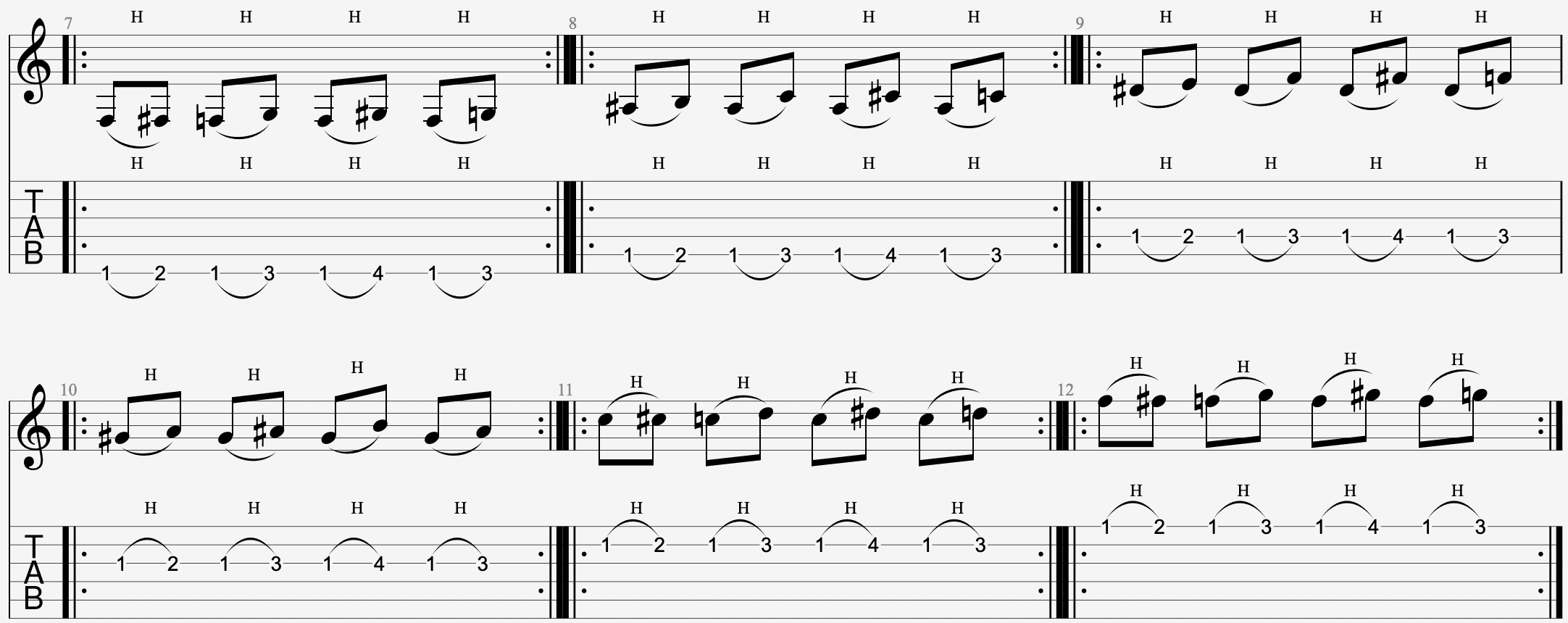Guitar warm-ups are an essential part of playing guitar or really any musical instrument, especially as we get older. Warming up both hands prior to a long practice session, rehearsal, or gig is essential. Guitar warm-up exercises build strength and dexterity while also helping to prevent common injuries such as carpal tunnel syndrome.
These types of guitar exercises can be deceptively simple to learn, yet technically complex to master. Despite being done in only 10-15 minutes per day, the benefits to your guitar playing can last a lifetime. Let’s take a look at a few of my 5 favorite essential guitar warm-ups.
#1 – Chromatic Single Direction Picking
Building finger dexterity as well as developing good guitar technique is a crucial step in becoming a better guitarist. By practicing exercises that focus on strengthening and stretching your fingers, you will improve your ability to play virtually anything. Don’t forget the picking hand. Whether your a Metal shredder or Folk finger-style player, picking hand technique is equally important in your practice routines.
Let’s start with a simple exercise that utilizes all 4 fingers of the fretting hand. For this first exercise we’ll use only downstrokes on the picking hand:

Now, let’s take a variation on this by changing the finger combo to 1-2-4-3, and using Only upstrokes.

It’s very counterintuitive to play with only upstrokes, but it’s also an excellent way to wake up that picking hand.
What do Pro Guitarists Practice?
How does renowned Mr. Big and Racer X guitar legend Paul Gilbert get his amazing technique? Paul said in a recent interview with famed YouTube Musicologist Rick Beato that he uses a similar upstroke warm up to “wake-up” his right-hand. Furthermore, he explains how simple warm-up exercises like this get his insanely articulate alternate picking technique ready for the stage.
Consistent, daily technical practice will help keep both hands synced and facilitating fluidity in left and right hands allowing you to play the things you want to play, and with more confidence and ease.
As you work on building finger dexterity, remember to start slowly and gradually increase the speed as you become more comfortable with the exercises. In addition, focus on maintaining proper hand and finger positioning to prevent unnecessary strain and injury.
“Waking Up” the hands is a great analogy for what’s happening here. Once the hands are warmed up and limber, everything feels better. Just like your first cup of coffee in the morning, a good Yoga practice, or a walk on the treadmill is for the rest of your body.

Why Practice Guitar Technique?
I’ve seen a lot of guitarists on social media complaining about practicing a certain song or solo for hours, days, or even months on end with little or no improvement. In most cases, the guitarist hasn’t yet reached the technical facility required to play the song or solo.
Without those technical building blocks, some things are just (temporarily) impossible to play. Dedicating even a small portion of your daily guitar practice to technique will yield results that will improve every facet of your guitar playing.
#2 – Cross String Chord and Arpeggio Picking
This 2nd warm-up exercise focuses on mastering alternate or cross-picking through chords across multiple strings. Alternatively, you could also refer to these as arpeggios of a sort. If you’ve read any of my books, you know I love to snag little snippets of Classical music and create guitar exercises from them in addition to just being fun to play.
This is a very famous arpeggio sequence from the Prelude of Johann Sebastian Bach’s Lute Suite #4 In E Major. This one is equally fun with or without a pick. I love to do this one right before a gig with a heavily muted picking hand technique ala Al Di Meola.
It looks deceptively simple but gets harder once the string-skipping kicks in. Work on it slow and if you can are comfortable, use a metronome. Click on the image to get this longer exercise in a high-resolution .PDF.
Keep in mind you can also do these arpeggio patterns using all upstrokes, or all downstrokes for an added picking technique boost.
#3 – Hammer-on and Pull-offs
Let’s move away from picking drills for exercise #3. In this exercise we’ll be focusing on building that fretting hand strength using hammer-on and pull-offs, sometimes referred to as slurs, or legato playing techniques.

The ascending shape starts with a 1st to 2nd finger hammer-on before switching to the other available fingers. This leaves no finger left behind, ensuring the most efficient and complete workout for that fretting hand.
Descending in a similar pattern using pull-offs.

A simple yet extremely effective exercise!
#4 Pedal Points
Pedal points, also known simply as “pedals”, are sustained or repeated notes that serve as repeating or anchor point for moving bass and other notes within a scale. Pedal points are particularly common in Classical, and Baroque period music, but they also appear in other genres, including Jazz, Rock, and Metal. Yes, even Metal!
From Randy Rhoads groundbreaking playing in Ozzy’s first solo band, to modern Prog Metal giants such as Dream Theater and Opeth, Pedal Points can be found played in a a variety of ways. Let’s take a look at a few of my favorites.
Pedal #1 Single String Pedal Points
For this first pedal point, we’ll keep it all on the high E string in the A Harmonic minor scale (A B C D E F G# A). Use alternate picking throughout beginning with a downstroke.

For this second set of Pedal Points we’re going to move inside the A minor scale across the B and high E strings:

Feel the burn in your pinky finger? That’s good, but don’t overdo it! If you feel any pain, take a break, let it wear off and start again. You should also feel a significant improvement in strength in your fretting hand within the first week.
Examples of Pedal Points in Music:
- J.S. Bach: My favorite composer, his use of pedal points is prominent in his organ works, such as the Toccata and Fugue in D minor.
- Ludwig Von Beethoven: The slow movement of his Symphony No. 7 features a prominent pedal point as well as some other beautiful uses of counterpoint.
- 80’s Neo-Classical Metal: Pedal points can be found in various Metal genres. Check out some Neo-Classical stuff for example Yngwie, Vinnie Moore, and my favorite, Jason Becker for the very finest examples of Pedal Points on the electric guitar.
#5 Odd & Even Scale Shapes
Alternate picking using symmetrical 2, 3, or even 4 string scale shapes makes for an easy picking pattern. So what happens in real-world improvisation when things are mixed up using a combination of odd and even numbers of notes on each string? We get a great picking hand and fretting hand coordination warm-up.
In the first example, I’m using a scale you probably are familiar with, the A Blues Scale. What makes this scale harder to pick through is the 2, 3, 2, 3, 2, 2 note combinations. This makes our pick strokes feel a little off and can cause some disruption of the flow of ideas in our solos or improvisations.

In this next example, I’m using the A Melodic Minor scale. Melodic minor scales mapped out this way can be a great way to coordinate our picking and fretting hands due to the 2, 3, and sometimes even 4 string note clusters per string. Check it out, and be sure to use strict alternate picking ascending and descending through the scale to get the most benefits.

Keep in mind, those last two examples only use one shape from each of the two minor scales. If you want to expand your guitar warm-up even more, try doing 5-10 reps of each shape. If you need a refresher on more of these scale shapes check out my lessons on Melodic Minor Scales and complete Pentatonic and Blues Scales lessons below:
Melodic Minor Scales for Guitar
Complete Pentatonic and Blues Scales for Guitar Explained
Closing
Lastly, keep in mind that these exercises are just the tip of the iceberg so to speak on guitar warm-ups. These are just a few to help you incorporate some better practice habits in addition to creating a more focused daily practice and guitar playing routines. Until next time, happy practicing!

Craig Smith is a professional Guitarist, Teacher, and Writer living in Sanford, Florida. Craig has taught guitar lessons, performed 200+ gigs per year for nearly 30 years, and published 4 guitar instructional books. When he’s not gigging or writing, you may find him by the pool with his wife Celeste, 4 Chihuahuas, and a drink. 🎸

